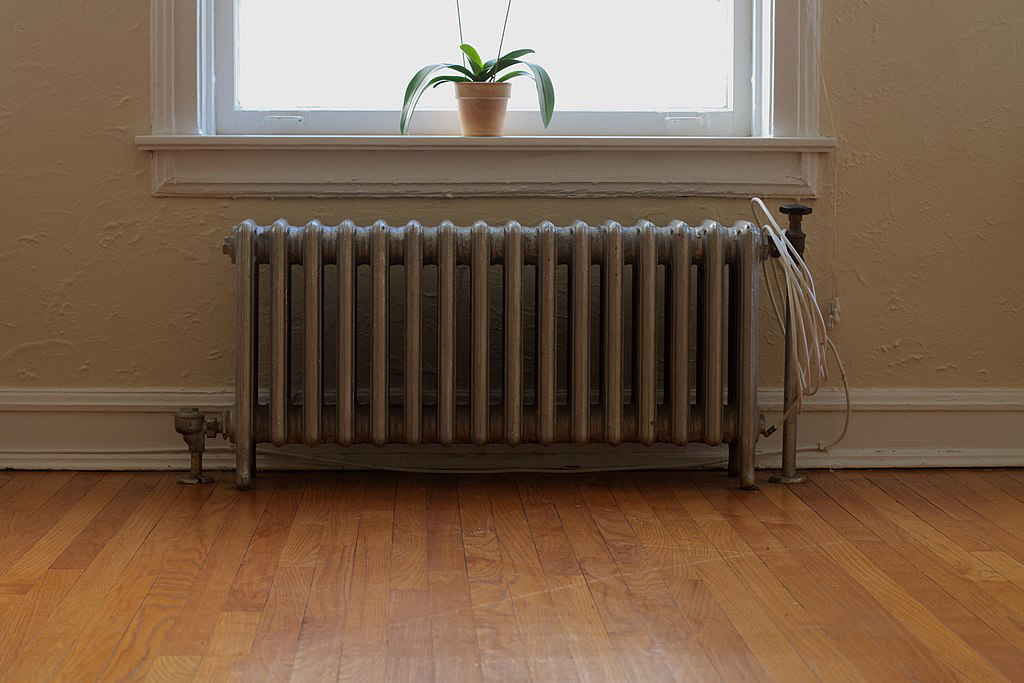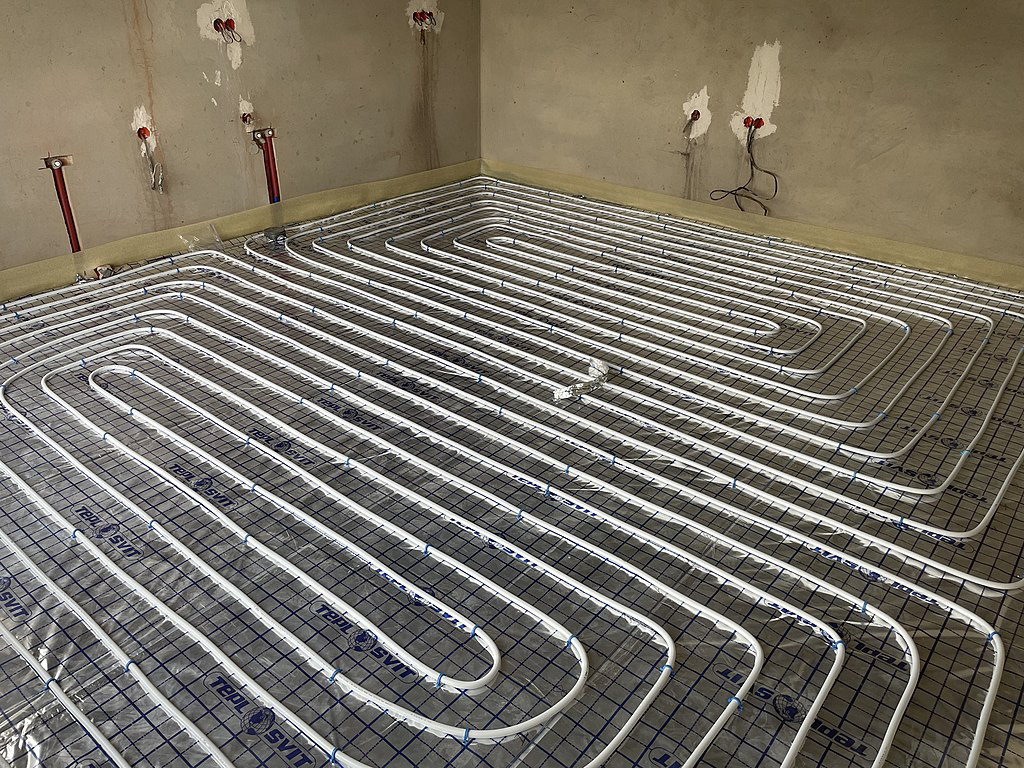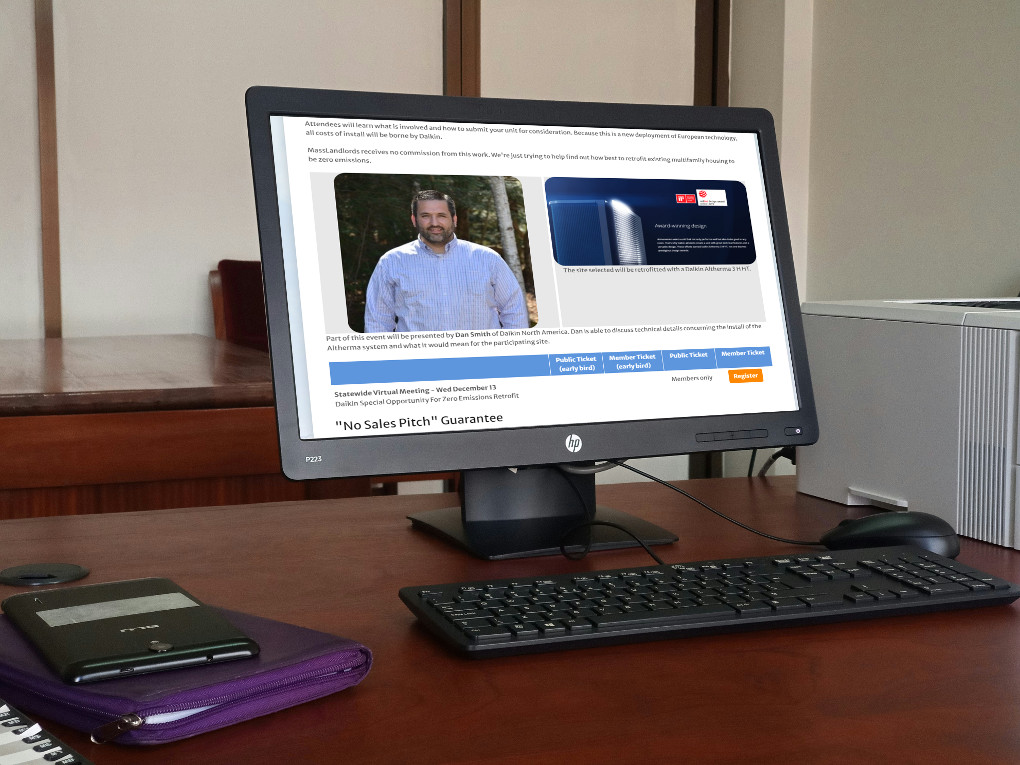Converting Baseboards and Radiators for Air-to-Water Heat Pumps
| . Posted in News - 2 Comments
By Eric Weld, MassLandlords, Inc.
Suppose you own a triple-decker or other multi-family built a century or more ago, and you want to convert your building’s water-based heating system away from fuel combustion to electric heat pumps. Can it be done without stepping foot inside any renter’s unit? Could you simply swap out the boiler?

Steel radiators like this one are a ubiquitous sight in triple-deckers and multi-families built in 19th and 20th centuries. Designed to last, these hydronic systems are still effective for providing heat – in some cases, too much heat. Image: cc by-sa Wikimedia commons.
The conversion away from fossil fuel-burning heating is essential. It helps mitigate climate change by removing your carbon from the atmosphere, assisting our state’s legal obligation of zero carbon emissions by 2050. It will also likely save you money in the long term. In theory, your heat pump system could also be more efficient than your gas, oil or propane fuel system. That efficiency will become increasingly important as rates for those finite, polluting fuels continue to rise.
But unless your building’s heat system has been upgraded already, you likely have a hydronic system, either forced hot water baseboards or radiators. You might still have steam radiators. Or, you might have installed a hydronic radiant floor heating grid. (If so, good on you. Radiant floor heating is expensive to install, but it’s the most efficient hydronic system.)
A fraction of multi-families may have been outfitted with ductwork and central air HVAC. If so, air-to-air heat pumps are available for integration with your ducted system. This doesn’t apply to most triple-deckers, which typically don’t have the available wall or ceiling space to install ductwork.
You know converting to electric is a near-future imperative. You have a hydronic heating system. What are your options for heat pump conversion?

Hydronic radiant floor heating systems install a grid of refrigeration pipes as a sublayer before installing flooring over the pipes. While these systems can be expensive to install, they are the most efficient hydronic systems available and provide high quality heating. Image: cc by-sa Wikimedia commons-Viii23dawari.
Air-to-Water Heat Pumps, aka A2WHPs
You’ve been reading about how air source heat pumps with interior mini-split exchangers (air-to-air) are the most popular option for electric conversions. In some multi-family buildings, mini-splits might work well and may be the simplest option for electric heat pump conversion.
But an air-to-air design might be impractical for your multi-family. Maybe your unit interiors have lots of walls with delightful-but-unusual room configurations like extra right angles, corner nooks and multiple levels. Or you might have enclosed porches, breezeways, extensions and additions, each needing dedicated heat. Providing heat via ductless mini-splits for your dwellings would require a legion of wall-mounted exchangers, sometimes more than one per room. Not practical.
And anyway, you’d like to keep the hydronic system you already have rather than replace it. Hydronic heating, after all, offers advantages over air-based systems, which we’ll detail below.
So, is there a heat pump solution for you? One that could both tie in with electric heat pumps and take advantage of the hydronic grid already installed in your dwellings?
The answer should be yes. Such options do exist, though they are limited and come with caveats. We have the technology. Air-to-water heat pumps (A2WHPs) capable of tying into your hydronic system are widespread in other parts of the world, and may become a significant part of the U.S. market.
Supply Water Temperature
For owners of buildings with hydronic heating systems, you might be better equipped for electric conversion than you thought. For heating an interior space, hydronic is considered superior to forced air. It’s quieter technology, and water has about four times more energy per mass than air, which translates into a higher heat capacity. And regardless of what kind of hydronic system you have, the radiant heat from forced hot water is more consistently distributed and remains longer in the heated space than systems that move air.
The primary issue with A2WHPs has been the temperature of supply water distributed to the radiant heaters (i.e., baseboards, convection radiators or under-floor pipes). For many years, most forced hot water heating systems were designed for high supply water temperatures, around 180 degrees Fahrenheit, for a couple reasons. One is to initiate convective airflow. Warm air rises, hot air rises quickly, and you can achieve proper hot updraft from a 180-degree heater. But that updraft does not occur at 120 degrees Fahrenheit (or only does so meagerly). Your lost heat input is therefore not proportional to the temperature difference. Its extra loss compared to 180 degrees is because of the loss of convective air flow. (Also, in steam radiators, a high supply water temperature is necessary to produce ample steam.)
But the story of why high-powered radiators have persisted into the 21st century is more interesting than practical. It was the influenza pandemic of 1918 and 1919 that influenced the home heating system designs that remain with us now, and are just beginning to change. It had been determined by Lewis Leeds, a health inspector for the army who was later with the Franklin Institute, that diseases were being caused by “vitiated,” unventilated air. He was largely correct. Leeds teamed with writer Harriet Beecher Stowe on a campaign to get Americans to leave their windows open, even through the winter. The so-called Spanish Flu pandemic kicked the trend into overdrive, especially after Leeds estimated that 40% of American deaths from flu were being caused by unventilated air.
In response to that successful campaign, radiator and heat system designers began producing high-powered radiators to offset the loss of heat from open windows. Those heating systems remain in place in many northern city buildings. You can tell which ones they are by the wide-open windows on freezing days.
Modern radiators, including baseboards, have vastly improved (as have ventilation systems). Today’s radiators can provide effective heating with supply water at lower temperatures – as low as 120 degrees Fahrenheit with a fan assist – if sized and configured adequately. But swapping out your baseboard system for all new units might be prohibitively expensive. It might also require a room redesign. While conventional baseboards crawl unobtrusively along the exterior walls, even behind furniture, new radiators are wall panels or registers. They sit like a piece of furniture, permanently in one place, taking up space.
You might as well install new ductwork and go for central air.
Aiming for High COP
The other important consideration in hydronic heat pump conversion is efficiency. Higher efficiency is partly achieved by minimizing the difference between the system’s hottest temperature and its coldest temperature. A system supplying very hot water input temperatures, like 180 degrees Fahrenheit, is much less efficient than one operating at a high of 120 F.
The Environmental Protection Agency, through tax incentives and state rebates, incentivizes the purchase of systems with higher efficiency performance, measured in coefficient of proficiency (COP). Specifically, federal and state credits are offered on purchases of systems with COPs of about 3 and above. (A system running up to 180 F is likely in the 2s.)
This policy is too stringent if the intent is to reduce emissions. Multi-family owners could reduce their buildings’ emissions considerably if incentivized with rebates and credits below the COP-3 threshold. Even a COP of 2 would still be twice as efficient as electric resistance heating.
Credits aside, some multi-family owners just want the easiest, most cost-effective heat pump conversion option available that can provide adequate supply water temperatures to tie in with the system already in the building. The options are limited, but here are a couple.

MassLandlords introduced members to the Daikin Altherma 3, a heat pump with high temperature output potential for hydronic baseboards. Computer and desktop licensed Keith Kasaija under the Unsplash license.
Two A2WHP Brand Options
Two heat pump brands currently manufacture high-temperature products for the U.S. air-to-water market.
Arctic Heat Pumps, a Canadian company, is a leading producer of air-to-water heat pumps for cold climates. The company’s Extreme High Temperature Heat Pump uses a two-stage compression cycle within a mono-block structure to deliver high temperature water for any hydronic system, even in subzero outdoor climates. It can also replace an oil, gas or propane boiler.
One caveat with the Arctic Extreme model: it uses R-410A refrigerant, a hydrofluorocarbon with relatively high Global Warming Potential (GWP). For that reason, R-410A is on the list of refrigerants being phased out for certain end uses in the U.S., though not yet for residential HVAC use.
However, even considering the possibility of an eventual phaseout of R-410A, “conversion to a new refrigerant is no problem” with Arctic products, notes John Ruhnke, an Arctic Heat Pump representative in Connecticut and Massachusetts. The product’s mono-block, self-contained unit would allow for simple switching of the heat pump component when a different, lower-GWP refrigerant is used. Arctic is lobbying for allowance of R-290 in the U.S. R-290 is a propane refrigerant widely used in Europe China and India for commercial refrigeration. Although R-290 has higher flammability (as high as methane gas), it has a GWP of 0.07, compared with approximately 2,000 for R-410A.
Daiken is another popular heat pump brand that offers a high temperature model for residential use. Its high temp product provides supply water up to 80 degrees Celsius (176 F), suitable for baseboard space heating.
Daiken promotes its Altherma model as an effective retrofit option for multi-families. Daiken representative Dan Smith offered a company-funded pilot installation for a MassLandlords multi-family owner last year. Daiken chose a six-family building for the project, owned by a member in Newburyport. The retrofit installed a system replacing one boiler serving all six units. While the Daiken pilot project retrofitted intensively for heating, cooling and domestic hot water, the Altherma is suitable for heating-only applications.
Like most heat pump manufacturers except Arctic, Daiken’s products use R-32 refrigerant in its U.S. products. R-32 has a lower GWP (675) and is not scheduled for phaseout. (R-32 also carries a higher flammability risk than R-410A, but is considered safe for use in HVAC with proper installation.)
Other heat pump manufacturers, such as Nordic, Sanden and SpacePak, offer residential heat pump systems that may tie in with hydronic installations. However, if one of your goals is not to enter rental units, these systems won’t work. They would likely require some modifications of piping and components to accommodate lower supply water temperatures than what your system is currently using.
What About Cooling?
One reason mini-split heat pump configurations are such a popular residential option across the U.S. is their ability to also provide space cooling. Mini-splits are manufactured for circulating refrigerant that can extract heat from air in wide-ranging temperatures, both external and internal. These machines are capable of transferring warmth from outside into a home’s interior, but also drawing warmth from inside air and transferring and disbursing it outside, thereby cooling the indoor space.
However, a major downside to using cold-rated heat pumps to cool is the “short cycling problem.” A heat pump is sized to deliver the required BTUs during the coldest days. But if you run it in reverse on a hot summer night, it will be way overpowered. It will cool a space faster than moisture can condense out of it, resulting in high indoor humidity, mold growth and a potential sanitary code violation.
For that reason, for dual heating and cooling, air-to-air heat pumps are not a perfect solution.
A2WHP Cooling
Air-to-water heat pumps are also capable of providing warming and cooling. That capability depends on your hydronic system.
A steam radiator is not capable of cooling a space. The steam that produces heat via a radiator is not physically capable of drawing heat from the space.
Hot water baseboards can be retrofitted to also provide cooling. It may be an expensive job, requiring a new set of insulated pipes to avoid condensation. A hot water conversion radiator or hot water baseboards can theoretically cool a space by running chilled water through them. A heat pump integration assists this approach with a circulation system and external heat exchanger (for disbursing the warm interior air to the outside) in place.
Just be careful: If the circulating water drops below the dew point anywhere along the line, either in the walls or inside the unit, there will be condensation and mold growth. This is why this approach also requires retrofitting. You must run insulated pipes to cool with water.
Before investing in a baseboard retrofit for cooling, be sure to compare the cost with that of installing a few mini-split units to be used specifically for cooling. Mini-splits can be effective space coolers when used solely for that purpose, and are almost certainly the more economical option.
Heat Pump Conversion in Europe
American homeowners with hydronic systems are more aligned with Europe than U.S. residential owners relying on forced air. Europe has long relied more on water-based heating and cooling than we have in the U.S. American homeowners became enamored of central air in the 1960s, seeing it as an optimal way to heat and cool interior spaces.
Partly as a result, European homes now enjoy a considerable edge in converting to electric heat pumps compared to American homes. The conversion edge in some countries is also the result of policies that disincentivized fossil fuel furnaces, nudging consumers toward heat pumps.
Norway, for one example, established such policies in the 1970s during the oil crisis, and kept them in place after the crisis passed. As a result, the Scandinavian country now has a higher percentage of homes heated with heat pumps – nearly two-thirds – than any other country.
Europe and the U.S. differ in their preferences for refrigerants. While R-410A has long been the standard in American home refrigeration (though that will change as it is banned for commercial and other uses), the European standard for much residential HVAC is R-1234yf, (with a GWP of less than 1) and R-1234ze for medium temperature applications. Europe is banning use of R-410A in new stationary air conditioning equipment as of Jan. 1, 2025. The U.S. has not yet announced a similar ban.
The Most Cost-Effective Heat Pump Conversion Plan
The key question when considering converting from fossil fuel-combustion heating to electric heat pumps is: what is the most short- and long-term cost-effective plan?
For many, the answer should be air-to-water heat pumps connected to an existing hydronic system: radiators, baseboards or radiant floor grids.
With new products entering the market in recent years that are designed for U.S. hydronics, this type of system offers a viable solution to the thousands of multi-family owners wondering how to convert their rentals to electric heat.
There are hundreds of scenarios and options for converting to non-fuel-burning heating and cooling for older rentals. Decisions for how to convert will consider preferences, cost, availability of equipment and the idiosyncrasies of your units and spaces. There will also have to be policy changes to recognize that COPs of 2 are allowable and should be incentivized for buildings in which air source is not a viable solution.
Air-to-Water Heat Pumps in Place
Arctic Heat Pumps is selling its products by the millions, says Ruhnke, and he insists the company’s air-to-water heat pumps are suitable for retrofits and adaptable for a range of systems.
Two of his recent customers attest to the systems’ efficacy in conjunction with radiant floor systems.
Eric Krueger installed an Arctic Heat Pump system in a new build in New Marlboro. His system heats his 2,100-square-foot residence with 60,000 BTUs, a typically sized unit for a whole house system. “I try to keep my system simple,” says Krueger, having installed two heat pumps to accommodate several zones. The one caveat he notes: his system circulates a glycol, or antifreeze, as part of its refrigerant mixture, to protect from freezing or over-viscosity during very cold days. The system electronically monitors its glycol level.
“I just worry a little,” he says, if his electricity goes out and the system fails to adequately supply glycol, prompting a precipitous drop in pressure and system shut-down.
For successful conversion to a heat pump hydronic system, Krueger also warns: be sure the building envelope is tight with sufficient insulation, windows and sealing.
It’s also vital to size the heat pump system correctly to the space and the hydronic system specs, notes Jim Frisbee, who recently installed an Arctic air-to-water system for radiant floor heating in his Rockland home’s two-story garage. “If this system works well,” he says, he will consider retrofitting his 1840 home, which is now heated via an oil furnace.
Both these systems were new builds. We are curious about hearing from rental owners, especially with older multi-families, who have retrofitted a hydronic system with heat pumps. If you have experience with air-to-water heat pumps, we want to hear from you. Drop us an email at hello@masslandlords.net.




